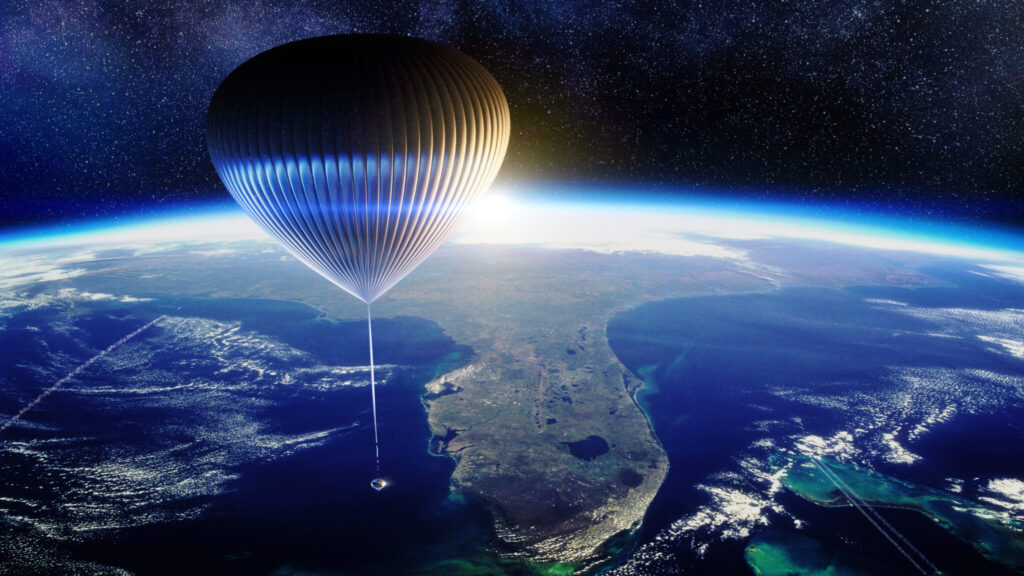The EOS-X capsule will carry passengers to the edge of space and back in comfort and style, with ergonomic seats, mood lighting and a toilet. Let’s hope there’s a drinks trolley too. Olivia Palamountain reports
EOS-X Space is pioneering an out-of-this-world experience like no other. Joining the likes of Virgin Galactic, Blue Origin and Space X in the race to get tourists into space, the Spanish start-up has designed a revolutionary pressurised capsule that will gently lift passengers into near space using stratospheric balloons.
The EOS – X capsule has been designed to optimise comfort and safety, with no strong accelerations and an interior that affords the best possible views and an enjoyable, smooth ride for up to five passengers and one crew member.
It takes about two hours for the craft to reach an altitude of up to 40km (well above the flight level of commercial aircraft at around 10km), followed by two hours of cruising and a final descent and landing of around an hour.
During the flight, passengers will be able to admire the curvature of the Earth and the blackness of space from personal panoramic windows. The capsule is fitted with ergonomic seats, mood lighting and a lavatory. A control panel to relays real-time information about the flight.
“Companies like Blue Origin, Space X and Virgin Galactic are offering high-altitude flights that only last a few minutes,” EOS-X Space founder Kemel Kharbachi told Spanish outlet Europa Press. “We’ll be allowing passengers to see the curvature of the planet in an unforgettable journey lasting hours.”
The price of a ticket will be between US$150,000 and US$200,000 per person, with the first commercial flight set to take place in 2023. EOS-X Space wants to take some 10,000 people to the edge of space within the next ten years. The company hopes to have a presence across Europe, the US, the Middle East and Asia.

The EOS-X experience begins well before the flight itself. No space suits or physical preparation is necessary for for the trip, however, two-three days prior to the flight, passengers are welcomed at the “stratoport” complex for a series of training, preparation and briefing sessions.
After a dawn wake-up call at the complex, passengers are suited and booted in tailored EOS-X gear before heading to the capsule. Once safely strapped into their seats, EOS-X begins its ascent into near space.
Friends and family who are not flying are also welcome at the stratoport. They can experience some of the briefing and preparation sessions and follow the flight via HD live video streaming from the EOS-X capsule.
EOS-X is as sustainable and low-impact as possible, driven by the company core principles and vision of “reconnecting with mother Earth”.
Flights are powered by helium or hydrogen, both zero emission gases, and the balloon envelope is collected upon landing before being recycled (EOS-X is working towards achieving balloon reusability long term). The company is also committed to offsetting the carbon footprint of EOS-X support activities.
EOS-X’s founder is also the CEO of Palma de Mallorca-based Spanish tech hub Agora Next, which is aimed at start-ups in the tourism sector.
“Our mission is for the space to become a new tourism industry in itself,” Kharbachi said, according to Trends Today. “The fascination with space flight is universal and, as we develop technology and new infrastructure, there will be more opportunities for everyone to get involved. Democratisation is at the heart of our business and is what will drive the new era of space tourism.”
Stratospheric balloon flights: the contendors
 This is not the first time high-altitude balloons have been mooted as a means to space travel. Globetrender has reported on initiatives such as World View, a project by the Paragon Space Development Corporation that will see a capsule rise 30,000 metres by means of a helium balloon and the PriestmanGoode-designed balloon project Space Perspective, which also rises 30km into the air.
This is not the first time high-altitude balloons have been mooted as a means to space travel. Globetrender has reported on initiatives such as World View, a project by the Paragon Space Development Corporation that will see a capsule rise 30,000 metres by means of a helium balloon and the PriestmanGoode-designed balloon project Space Perspective, which also rises 30km into the air.
Spaceship Neptune will be flown by a pilot with up to eight passengers, called Explorers, on board. The entire experience will take roughly six hours – a two-hour ascent above 99 per cent of the Earth’s atmosphere, a two-hour flight at 100,000ft above ground and then a two-hour descent. The Spaceship Neptune will land in the sea where a ship will retrieve the passengers, capsule and balloon.
Meanwhile, Bloon, part of Zero to Infinity, is looking at taking its guests even higher – up to a giddy 36km, which is above 99.5 per cet of Earth’s atmosphere.
